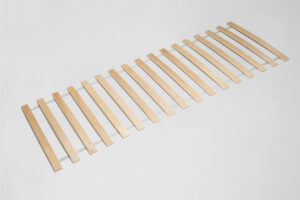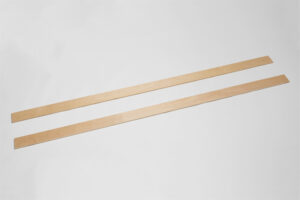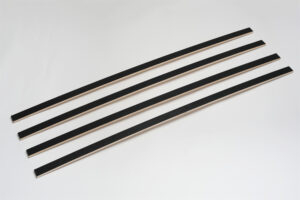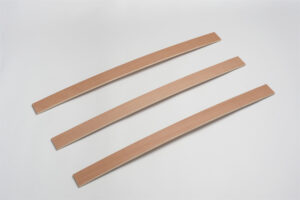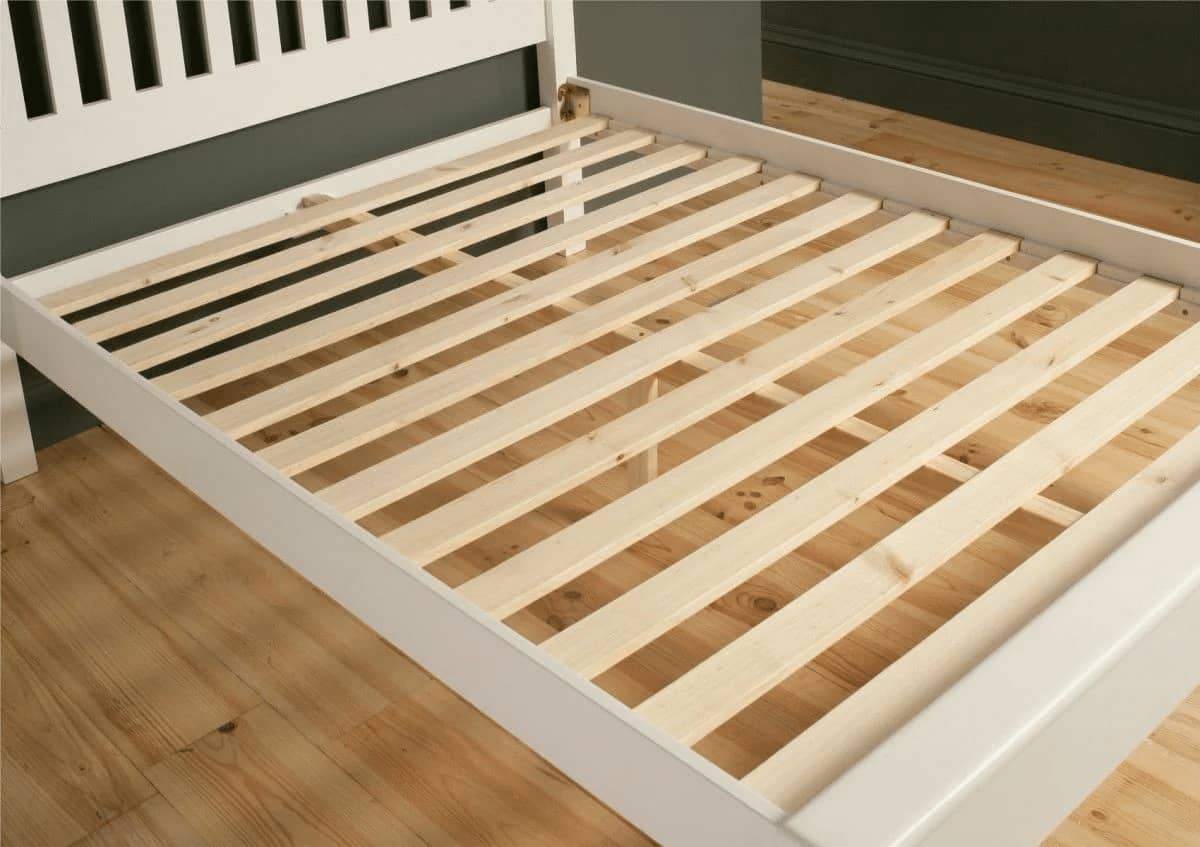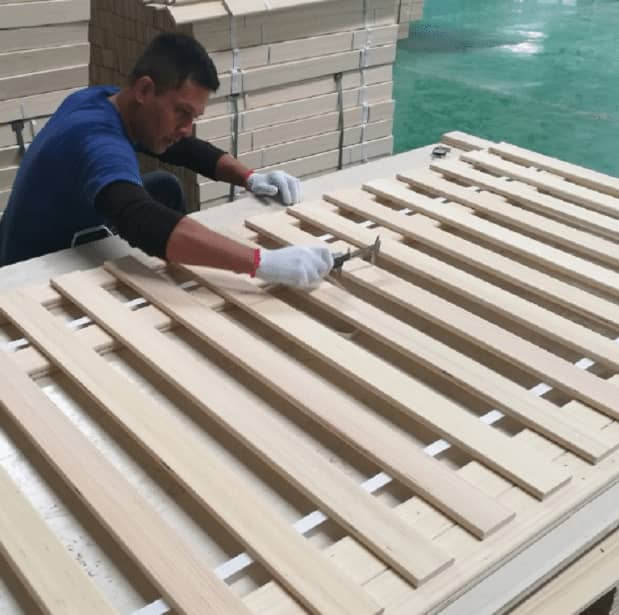The furniture industry thrives on a delicate balance of comfort, style, and durability. While plush fabrics and eye-catching designs often steal the spotlight, the unsung hero of a good night’s sleep – the bed slat – plays a crucial role in customer satisfaction and brand reputation. Choosing the right bed slat material isn’t just about supporting a mattress; it’s a strategic decision that impacts your brand identity, production costs, and ultimately, your bottom line.
This guide goes beyond the surface, equipping furniture manufacturers, retailers, and hospitality businesses with the knowledge to confidently navigate the world of bed slat materials. We’ll explore the key considerations that will help you select the perfect material to elevate your brand and ensure your customers sleep soundly.
Why Sweat the Small Stuff? The Impact of Bed Slat Material
Before diving into the specifics of each material, let’s take a moment to understand why this seemingly small detail deserves your attention. The choice of bed slat material can have a ripple effect on various aspects of your business:
- Shape Brand Perception: In the competitive furniture landscape, brand perception is everything. The materials you choose for your products, even those hidden beneath a mattress, communicate your brand’s values and the experience you aim to deliver. Are you a brand that prioritizes natural materials and craftsmanship, opting for the timeless appeal of solid wood? Do you focus on durability and longevity, selecting materials known for their strength and resilience? Or perhaps your brand identity centers around accessibility and value, offering well-crafted furniture at approachable price points? Your bed slat material can subtly, yet powerfully, convey these messages to your discerning customers.
- Influence Production Costs: Managing costs is crucial for maintaining healthy profit margins, and the choice of bed slat material can significantly impact your overall production budget. Factors to consider include the raw material cost, which can fluctuate based on availability and sourcing practices; manufacturing processes, with some materials requiring more labor-intensive techniques; shipping weight, as heavier materials can increase transportation expenses; and even waste disposal, as some materials may require specialized handling.
- Determine Product Lifespan: A bed frame is only as strong as its foundation, and the lifespan of your products is directly linked to the durability of the materials used. Different bed slat materials offer varying levels of strength, flexibility, and resistance to wear and tear. Consider the weight capacity your beds need to support, the desired lifespan of your products, and whether factors like moisture or temperature fluctuations might come into play. Choosing a material that can withstand the test of time not only reduces replacement costs but also minimizes waste and reinforces your brand’s commitment to quality.
- Impact Environmental Footprint: In today’s environmentally conscious marketplace, consumers are increasingly drawn to brands that prioritize sustainability and ethical sourcing. Choosing bed slat materials made from renewable resources, manufactured using eco-friendly processes, and sourced from responsibly managed forests can be a powerful differentiator for your brand. By making conscious material choices, you not only reduce your environmental impact but also appeal to a growing segment of consumers who are actively seeking out brands that align with their values.
Navigating the Material Landscape: 5 Key Considerations
Now that we understand the impact of this often-overlooked component, let’s explore the key considerations to guide your decision-making process, empowering you to choose the bed slat material that aligns with your brand identity, production capabilities, and target market:
1. Define Your Brand Identity and Target Audience:
Before diving into the specifics of each material, take a step back and define your brand’s core values and target audience. This crucial step will serve as your compass as you navigate the material landscape.
- What experience do you want to create for your customers?
- Luxury and exclusivity? This might involve using premium materials like high-grade hardwoods or sleek metals, focusing on craftsmanship and attention to detail.
- Durability and longevity? Choosing materials known for their strength and resilience, such as hardwoods or metal alloys, will be key.
- Affordability and accessibility? Opting for cost-effective yet durable materials like plywood or engineered wood products can help you achieve this goal.
- Sustainability and eco-consciousness? Prioritizing materials from renewable resources, recycled content, or those with minimal environmental impact during manufacturing will resonate with this audience.
- Who are your ideal customers, and what are their priorities?
- Price-conscious families? Durability, functionality, and value for money will be paramount.
- Eco-conscious millennials? Sustainability, ethical sourcing, and transparency in your supply chain will be key considerations.
- Discerning customers seeking heirloom-quality pieces? Craftsmanship, the use of premium materials, and timeless designs will be highly valued.
2. Evaluate Material Properties and Performance:
Each bed slat material comes with its own set of strengths and limitations. Understanding these nuances is crucial for making informed decisions that align with your product goals and customer expectations. Let’s break down the most common options:
| Material | Pros | Cons | Ideal Applications |
|---|---|---|---|
| Solid Wood | Timeless Appeal: Exudes warmth, craftsmanship, and a classic aesthetic that never goes out of style. Durability: Known for its strength and longevity, especially hardwoods like oak, maple, or cherry. Sustainability: When sourced from responsibly managed forests, solid wood is a renewable and biodegradable material. | Cost: Can be expensive, especially for hardwoods and depending on availability and sourcing practices. Weight: Heavier than other options, potentially impacting shipping costs. Susceptibility: May require treatment to prevent moisture damage or pest infestations. | High-End Furniture: Ideal for brands crafting heirloom-quality pieces where aesthetics and longevity are paramount. Traditional Designs: Complements classic bed frame styles and appeals to customers seeking a natural, authentic look. Sustainable Choices: Appeals to environmentally conscious consumers when sourced from responsibly managed forests. |
| Plywood | Cost-Effective: Generally more affordable than solid wood, making it a budget-friendly option. Lightweight: Reduces shipping costs and makes assembly easier. Versatility: Available in various thicknesses and grades to meet different strength and design requirements. | Durability: While strong for its weight, plywood can be less durable than solid wood, especially in humid environments. Aesthetics: Lacks the natural grain pattern of solid wood, which might not be suitable for exposed applications. Potential Concerns: Manufacturing processes can involve adhesives that may contain formaldehyde or other volatile organic compounds (VOCs). | Budget-Friendly Furniture: A practical choice for manufacturers and retailers offering value-driven products. Platform Beds: Well-suited for platform bed designs where slats are typically hidden beneath the mattress. High-Volume Production: Cost-effectiveness and ease of manufacturing make it suitable for large-scale production runs. |
| Metal | Strength and Durability: Exceptionally strong and resistant to wear and tear, moisture, and pests. Modern Aesthetic: Complements contemporary and minimalist bed frame designs. Low Maintenance: Typically requires minimal upkeep and is resistant to warping, cracking, or fading. | Cost: Can be more expensive than wood options, especially for higher-grade metals or specialized finishes. Comfort: Can feel cold to the touch and may require padding or insulation for optimal comfort. Noise: Metal slats can sometimes squeak or make noise if not properly secured or padded. | Modern Furniture: Aligns with sleek, minimalist designs and appeals to customers seeking a contemporary aesthetic. Adjustable Beds: Strength and durability make it suitable for adjustable bed frames that require frequent movement. Contract Furniture: Often used in hospitality or institutional settings where durability and low maintenance are priorities. |
3. Align Material Choice with Bed Frame Design:
The design of your bed frame plays a crucial role in determining the visibility of the slats and the overall aesthetic you’re aiming to achieve. Consider whether the slats will be a visible design element or hidden beneath the mattress:
- Exposed Slats: If the slats will be visible, they become an integral part of the bed’s overall aesthetic. In this case, prioritize materials that enhance the bed’s visual appeal. Solid wood, with its natural grain patterns and warm, inviting feel, can add a touch of sophistication and craftsmanship. Metal, especially when finished with a sleek powder coating or a brushed effect, can lend a contemporary and minimalist vibe.
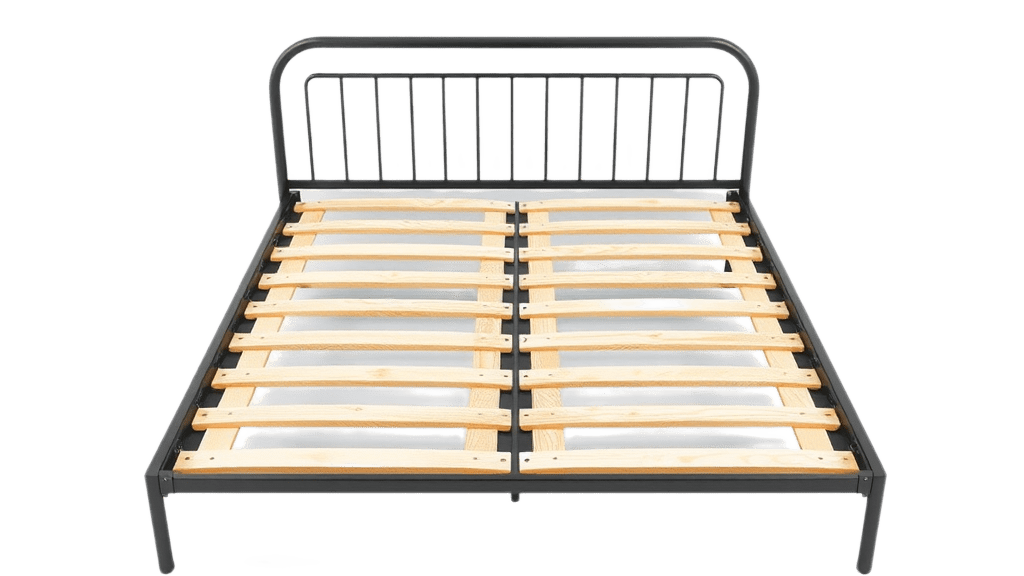
- Hidden Slats: If the slats will be hidden beneath the mattress, functionality and cost-effectiveness take precedence over aesthetics. Plywood, with its affordability and reliable strength, becomes a practical choice. Metal, while potentially pricier than plywood, offers exceptional durability and longevity, making it a worthwhile investment if your bed frames are subjected to heavy use or frequent assembly and disassembly.
4. Prioritize Sustainability and Responsible Sourcing:
In today’s environmentally conscious market, demonstrating your commitment to sustainability is no longer a marketing tactic – it’s a core value that resonates deeply with consumers. By prioritizing sustainable and ethically sourced materials, you not only reduce your environmental footprint but also enhance your brand image and appeal to a growing segment of conscious consumers.
- Seek out certifications: Look for certifications like Forest Stewardship Council (FSC) for wood products, which ensure that materials are sourced from responsibly managed forests that prioritize environmental conservation, social responsibility, and economic viability.
- Explore recycled or reclaimed options: Consider using recycled metal, which reduces the demand for virgin materials and minimizes mining’s environmental impact. Reclaimed wood, salvaged from old structures or discarded furniture, adds character and history to your pieces while reducing deforestation.
- Partner with transparent suppliers: Transparency and traceability are crucial for building trust with your customers. Work with suppliers who are open about their sourcing practices, manufacturing processes, and commitment to ethical and sustainable operations. Don’t hesitate to ask questions, request documentation, and visit their facilities to ensure their values align with yours.
5. Analyze Costs and Long-Term Value:
While it’s tempting to focus solely on upfront costs, consider the long-term value and potential hidden expenses associated with each material. A holistic approach to cost analysis will help you make strategic decisions that optimize both your budget and your product’s lifespan.
- Durability and Lifespan: While a more durable material might have a higher initial cost, it could result in lower replacement costs and less waste over time. Consider the expected lifespan of your products and the potential costs associated with repairs, replacements, and disposal.
- Maintenance Requirements: Some materials, like untreated wood, might require regular maintenance to prevent damage, adding to the overall cost of ownership. Factor in the time, effort, and materials required for upkeep when comparing material options.
- Shipping and Handling: Heavier materials like solid wood can increase shipping costs, especially for larger orders or long-distance deliveries. Consider the weight of the materials, the packaging requirements, and the distance your products will travel when evaluating transportation expenses.
Why Choose Yuantuo Wood for Your Bed Slats Materials?
At Yuantuo Wood, we understand that the foundation of a good night’s sleep lies in quality craftsmanship and carefully selected materials. That’s why we go above and beyond to provide bed slats that not only meet but exceed industry standards, aligning with the key considerations outlined in this guide:
- Uncompromising Quality: We source only the finest hardwoods, including oak, maple, and cherry, known for their exceptional strength, durability, and natural beauty. Our rigorous quality control processes ensure that every slat meets our exacting standards.
- Sustainable Sourcing: We are committed to responsible forestry practices and partner with suppliers who share our dedication to environmental stewardship. Our wood is sourced from sustainably managed forests, certified by the Forest Stewardship Council (FSC), so you can rest assured that your choice supports healthy forests for generations to come.
- Tailored Solutions: We offer a range of slat sizes, spacing options, and finishes to meet your specific design requirements and aesthetic preferences. Whether you’re crafting high-end furniture, budget-friendly options, or anything in between, we have the perfect bed slat solution for your brand.
- Partnership Approach: We believe in building lasting relationships with our clients, providing expert guidance and support throughout the entire process, from material selection to production and delivery.
Contact us today to discuss your bed slat needs and discover how Yuantuo Wood can help you create furniture that reflects your commitment to quality, sustainability, and customer satisfaction.
Frequently Asked Questions About Bed Slat Materials
We understand that choosing the right bed slat material can be a detailed process. Here are answers to some common questions we receive, providing further clarity to empower your decision:
1. What is the most durable bed slat material for heavy-duty use?
While both solid wood and metal offer excellent durability, metal bed slats are generally considered the most robust option for heavy-duty applications. They exhibit exceptional strength, resistance to wear and tear, and hold up well under significant weight. Metal slats are particularly well-suited for:
- Plus-size individuals or couples: Offering consistent support and preventing slat breakage.
- Adjustable bed frames: Withstanding frequent movement and adjustments without compromising integrity.
- Environments prone to moisture or pests: Resisting damage and maintaining their structural integrity over time.
2. What type of wood is best for bed slats, considering both aesthetics and durability?
When choosing wood for bed slats, hardwoods are the superior choice. Oak, maple, and cherry are popular options, prized for their strength, durability, and attractive grain patterns.
- Oak: Known for its prominent grain and robust strength, making it suitable for heavier mattresses and long-term use.
- Maple: Offers a smoother, more subtle grain pattern and is prized for its hardness and resistance to scratches and dents.
- Cherry: Offers a rich, reddish-brown hue that deepens with age, adding a touch of elegance and warmth to furniture.
These hardwoods can withstand heavy weight and resist warping or cracking over time, ensuring lasting performance and aesthetic appeal.
3. Are wooden bed slats better than metal, or vice versa?
There’s no definitive “better” option – the choice between wood and metal slats depends entirely on your priorities and the specific application.
Wooden Slats:
- Pros: Natural warmth and beauty, timeless aesthetic, sustainability when sourced responsibly, can be more cost-effective depending on the type of wood.
- Cons: Susceptibility to moisture damage and pests (if not treated), can be heavy, may require more maintenance.
Metal Slats:
- Pros: Unmatched strength and durability, modern aesthetic, low maintenance, resistant to moisture and pests.
- Cons: Can be more expensive, may feel cold to the touch, potential for noise if not properly secured or padded.
Carefully weigh these factors to determine which material aligns best with your desired aesthetics, budget, and performance requirements.
4. How do I choose the right bed slat spacing for optimal support and comfort?
Slat spacing significantly impacts both the support and feel of the mattress. Here’s a general guideline:
- Closer Spacing (2-3 inches apart): Provides firmer, more rigid support and is generally recommended for:
- Heavier mattresses, especially those made with dense materials like memory foam.
- Mattresses with less internal support, such as those with a simple innerspring system.
- Individuals who prefer a firmer sleep surface.
- Wider Spacing (4-5 inches apart): Offers more flexibility, breathability, and a slightly softer feel. This spacing is often suitable for:
- Lighter-weight mattresses.
- Mattresses with strong internal support systems, such as those with zoned support or reinforced edges.
- Individuals who prefer a bit more “give” in their sleep surface.
It’s important to note that mattress manufacturers often provide recommendations for slat spacing, so be sure to consult those guidelines as well.

